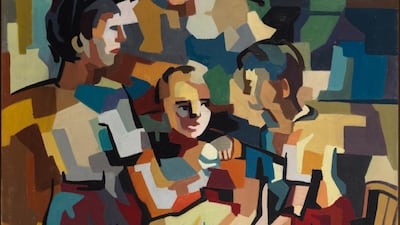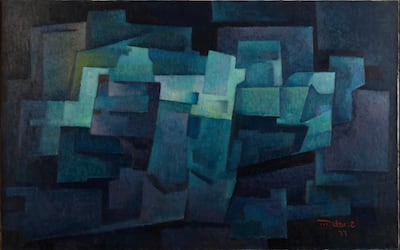Baghdad and Lisbon are two cities that don't appear to have much in common, but the paintings by Iraqi modernists now hanging off the walls of the Calouste Gulbenkian Foundation in Portugal have forged a lasting connection between the two cities.
Thirty works by 18 of Iraq's most distinguished artists, which have never been shown before, are now on display at the foundation, unmasking the murky history of Armenian oil tycoon Gulbenkian's intervention in Iraq.
Known as the godfather of Iraq's oil industry in the early 1950s, the businessman was one of the richest men of his time, after he fled Armenia and set about working in international affairs, representing a number of different countries' governments.
Mr Five Percent
Perhaps his most important legacy is that of the decisive role he played in mediating international negotiations that led to the exploitation of Iraq’s oilfields.
Nicknamed, “Mr Five Percent”, Gulbenkian’s influential role in the country’s oil establishment left him with a 5 per cent stake in Iraq’s Petroleum Company.
He also insisted that five per cent of the Iraq Petroleum Company’s workers in the field be Armenian.
With his incredible wealth gained by stakes in petroleum companies, Gulbenkian invested in the development of Iraq's culture, art, education, science and welfare sectors.
Throughout his life, he collected timeless artworks that were influenced by his travels and personal taste.
The businessman and art collector spent his last years in Lisbon. It was here that here he established in his will a foundation that would bear his name and benefit the international community.
Since its establishment in 1956, its strategy has been to "improve the quality of life through art, charity, science and education."
Supporting local artistic creations
The collection in the exhibition in Portugal presents unpublished documents relating to the foundation’s three key achievements in Baghdad: building the Modern Arts Centre, the People’s Stadium and the 1966 Gulbenkian Cultural Centre.
It acquires rare and unique artworks to create a programme of activities with Iraq and its government, according to Patricia Rosas, curator of the foundation.
"The intention of the foundation was to support local artistic creations and education by endowing Baghdad with its first purpose-built exhibition space for modern art," she explains.
The exhibit is displaying unusual and expressive works by artists who have proved to be key figures in the history of modern Iraqi art – ranging from paintings and drawings to prints, acquired directly from both individual artists and from the Iraqi Artists Society.
"The set of works shown here is the result of a set of efforts to promote artistic creation and training of artists between Baghdad and Lisbon," she says. Among the works on display are those of Hafidh Aldroubi, founder of the Impressionist Group movement; Jewad Selim, founder of the Baghdad Modern Art Group in 1952; and Faiq Hassan, who is often referred to as the father of Iraqi modern art. It also creates a dialogue between cultural development and economic diplomacy between Iraqi and Portuguese art and architecture.
Investing back into Iraq
Nada Shabout, a professor of art history at the University of North Texas, gave a lecture at the foundation last Wednesday, on Iraq's arts and cultural scene during the 1960s and the various cultural formulations and shifts in Baghdad. "The exhibition is a journey through the experiences of Gulbenkian and Iraq," she said.
"The way the exhibition is displayed is through interesting timelines of Gulbenkian's involvement in Iraq. It has original archival materials along with architectural drawings and videos." Iraq has been plagued by decades of conflict and devastation that have led to the loss of numerous paintings and significant cultural landmarks, which meant an exhibition like this was crucial.
"At this moment in time when the world seems to continuously forget about Iraq and its art and culture, it's important to have ventures like this that remind the world and gives Iraqis global attention," Shabout said.
Gulbenkian invested back into Iraq, Shabout said, as he genuinely cared about sponsoring various projects. "The paintings are unique and excellent examples and include the works of Iraqi modernists, whether Faiq Hassan or Hafidh Aldroubi. These are important pieces, [and]we didn't really know where they were before."
An opportunity to view Middle East art
Ala Basher, famed Iraqi artist and plastic surgeon, knows the impact many of the artists on display had on Baghdad, and the art industry as a whole. Aldroubi's paintings are characterised by his way of incorporating different styles, ranging from cubism to impressionism, which was interlinked with his career as an art educator, Basher said.
"Aldroubi is one of the greatest artists of Iraq, his technique was close to the impressionist style. He was a master of colours, as he loved to play with shades, tones and hues," Basher said.
He was also greatly dedicated to providing knowledge and resources to the future artists of Iraq. Aldroubi became one of the first Iraqi painters to integrate both impressionism and cubism in his works. This helped him conceive the Iraqi impressionist group, which Basher joined in 1959.
There are two paintings that belong to Aldroubi, currently on display at the foundation. The Family is a cubist style painting of Aldroubi's own family. The second, titled Harmony in Blue, is an abstract that incorporates different styles of colour.
"We are delighted that the gallery is giving the public the opportunity to know more about Middle Eastern art. Hafidh would have been honoured to have his work on display among other prestigious artists from the region," says Sohaila Derwish, Aldroubi's wife.
In fact, the majority of his work was influenced by western art trends, where he was able to move freely between realist, impressionist and cubist styles that mostly focused on Iraqi subject matters, she explains.
"I hope this gallery will be an opportunity for the world to discover and know about Hafidh and other Iraqi artists, their work, achievements and the influence they had in shaping Middle Eastern art," Derwish said.
The project is promoted by the Calouste Gulbenkian Museum and the Art Library and Gulbenkian Archives, with the support of the Grants Department.
Art and Architecture between Lisbon and Baghdad runs until January 28
_________________
Read more:
My grandfather, the man who coloured the streets of Baghdad
Yanni to perform Valentine’s Day concert at Abu Dhabi's du Forum
From Momoland to George Ezra: UAE concerts to look forward to in 2019
The most important man in pop music is someone you've probably never heard of
_________________





